Featured Articles
- 12 Essential Cognitive Principles That Underpin Exceptional Frontend Web Design Mastery
- “Beyond Aesthetics: How Neurodiversity Shapes Frontend Web Design for Inclusive User Experiences”
- Beyond Aesthetics: The Role of Emotional Design in Frontend Experiences
- Decoding the Unseen: How Quantum Computing Could Revolutionize Frontend Web Design Techniques
- The Art of Accessibility: Designing Web Experiences That Everyone Can Feel Good About
The Art of Chaos: Embracing Imperfection in Frontend Web Design for Unique User Experiences
The Art of Chaos: Embracing Imperfection in Frontend Web Design for Unique User Experiences
The world of frontend web design is evolving, moving away from the rigid perfectionism of the past toward a celebration of chaos and imperfection. By embracing these concepts, designers can cultivate unique user experiences that engage audiences in unexpected ways.
The Beauty of Imperfection
As a 25-year-old web designer immersed in the ever-changing digital landscape, I've come to appreciate that perfection is overrated. To paraphrase the age-old adage, sometimes the cracks in life let the light in—think about it! Embracing imperfection can lead to more relatable, authentic designs.
Why Chaos is Welcome
Many people might assume that a clean, structured design is the way to engage users effectively. However, research indicates that 42% of visitors are attracted to websites that possess unique design elements that stand out from the crowd (Nielsen Norman Group, 2023). In other words, chaos, when harnessed properly, can become a driving force behind user engagement and brand loyalty.
The Psychology of Design Choices
When embarking on a design project, understanding the psychology behind user behavior can find a sweet spot between chaos and order. For example, a case study conducted by Adobe revealed that users are more likely to remember and engage with designs that elicit a sense of surprise or intrigue (Adobe, 2019). An unexpected twist, such as an unusual animation or an asymmetrical layout, can create memorable experiences and foster emotional connections.
Case Study: The Airbnb Effect
Airbnb is a prime example of a company that thrives on the art of chaos in their user experiences. Their homepage boasts an effortlessly casual vibe that contrasts with the cookie-cutter approaches of traditional hospitality websites. By promoting local experiences and creative property listings, Airbnb's unique approach encourages users to embrace the unpredictability of travel and enjoy planning their adventures.
Are You in Fear of Missing Out on Imperfection?
For some, the thought of deviating from traditional design principles may seem daunting. However, in the spirit of adventure, let’s encourage you to let go of that fear! Consider this: the "FOMO" (Fear of Missing Out) mentality can influence user behavior significantly. An extraordinary design might prompt users to explore your website more thoroughly, driven by the thrill of unexpected discoveries.
The Design of the Future: Fluidity and Adaptability
As our digital lives shift toward a more fluid experience, designers must adapt to ever-changing user needs. For instance, a study published in the Journal of Usability Studies found that websites that adapt their structures based on user behavior saw a 32% increase in time spent on-site (Tullis & Albert, 2020). By employing chaos strategically, designers can create environments that respond to real-time user actions.
Creating Unique User Pathways
Once users step onto your website, why not provide them with pathways that captivate their sense of adventure? By using non-linear navigation, integrating unconventional layouts, and introducing playful micro-interactions, designers can shift users from a rigid browsing experience to an emotional voyage filled with delightful surprises. Remember, this is not about pandemonium but instead a deliberate orchestration of controlled chaos!
Injecting Personality into Designs
Part of what makes a website memorable is its personality. Take, for instance, the playful, quirky approach of MailChimp. With its whimsical illustrations and mismatched typography, the website conveys a sense of lightheartedness, making users feel at ease as they navigate the platform. By allowing a bit of chaos into their branding, the company demonstrates that it’s okay to let loose while crafting an effective user experience.
The Role of Color in Chaos
When designed thoughtfully, color can evoke emotions and engage users on a subconscious level. A study by the Institute for Color Research revealed that color can increase recognition of a brand by 80%. So, why not experiment with bold color palettes that challenge traditional design norms? A vibrant color scheme can create an atmosphere of excitement, encouraging users to linger longer on your site.
The Challenge of Balancing Order and Chaos
Even in embracing chaos, balance is essential—think of it like a dance. The key is to maintain a harmonious blend of structure and unpredictability. Remember the famous quote by Leonardo da Vinci: “Simplicity is the ultimate sophistication.” Embrace complex design concepts while ensuring that users can easily navigate through the chaos without feeling overwhelmed.
User Feedback as a Litmus Test
To ensure that your chaotic designs resonate with users, always keep an ear to the ground for feedback. Tools like heat maps and user feedback surveys can offer valuable insights into how people interact with your site. For instance, a company called Hotjar provides analytics tools that help designers visualize user engagement, shedding light on which aspects of chaos are effective and which might veer into confusion.
Learning from the Greats
There’s much to learn from legendary designers like Steve Jobs and David Carson, who flourished by breaking conventions. Carson, known for his unconventional typography, challenges perceptions of how we read and design. By allowing themselves to step into the realm of chaos, these innovators brought forth compelling visual narratives that engage and intrigue users even decades later.
You Don’t Have to be a Professional
As an aspiring designer, you don’t have to feel intimidated by industry giants. The joy of web design lies in the process of experimentation and finding your unique voice. Even amateur designers can channel their creativity through chaotic themes. Pinterest—an untamed jungle of inspiration—shows the potential of unruly aesthetics. Users flock to the platform for its collage-like layout, which reflects real-life creativity. Dive in and have fun!
The Journey of Continuous Improvement
As you integrate chaos into your web design process, remember that it’s essential to be patient and willing to iterate. Many successful designs stem from numerous revisions, so don’t shy away from testing new ideas. Every trial and error presents the opportunity to hone your craft and solidify what makes your unique user experience shine.
Conclusion: Embracing the Art of Chaos
In the bustling landscape of frontend web design, embracing imperfection can lead to innovative user experiences that resonate deeply with audiences. By blending structured chaos, thoughtful design, and a touch of personality, we can create vibrant digital spaces that captivate users of all ages. So go forth, break the mold, and let the art of chaos inspire your web design journey!




